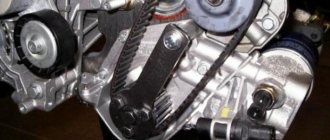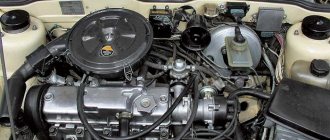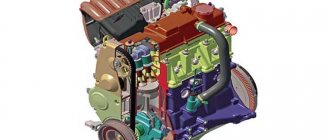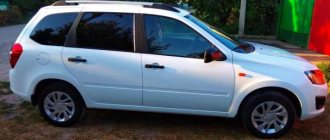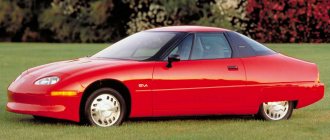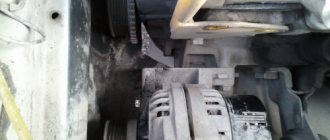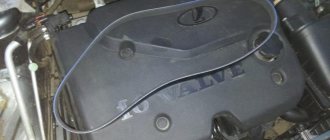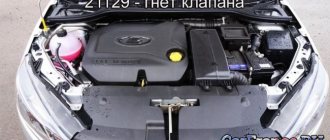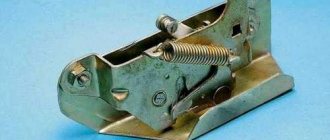The constant improvement of the internal combustion engine in order to increase efficiency and improve fuel efficiency has forced engineers to seriously rework the timing structure of modern diesel and gasoline engines. Changes also affected the design of the piston group and combustion chamber. These modifications were made to maximize the efficient filling of the cylinders and their high-quality ventilation, that is, to obtain improved gas exchange.
We also recommend reading the article about what a variable valve timing system is. From this article you will learn about what types of these solutions are installed on different engines, as well as the operating principles and design features of such systems.
If in the early stages of development the most common engine was with two valves per cylinder (1 intake and 1 exhaust valve), today an increase in the number of valves per cylinder is everywhere observed. Such changes are well illustrated by the most common version of the automobile internal combustion engine with four cylinders. Previously, such engines were often 8-valve, with one camshaft. Today, such a unit is often a 16-valve version with two camshafts (for intake and exhaust valves), can be equipped with a variable valve timing system, etc.
Why does the valve bend when the timing belt breaks?
You're driving along in your wonderful car, and suddenly there's a knock and the car stops. This is how the belt breaks. Everything would be fine if the belt just broke, but on some engines the valves immediately bend. Why is this happening?
The fact is that when the timing belt breaks, the camshaft, which drives the valve, stops, and the internal combustion engine crankshaft continues to rotate and push the pistons. The valves that are supposed to close remain in the lowered position and the rising pistons meet them.
How valves bend:
- The timing chain or belt has broken.
- The camshaft has stopped rotating.
- The crankshaft continues to rotate and push the pistons.
- Valves that go down and pistons that go up meet at top dead center (TDC).
- Pistons are stronger than valves, so the pistons bend the valves.
That is, if the timing belt breaks, the camshaft stops abruptly, and the engine crankshaft (even if it was immediately turned off) continues to rotate. The camshaft stops instantly and has no residual rotation because the return springs brake its cams. While the internal combustion engine crankshaft is rotating, the pistons will hit the open valves. Although the material of the pistons is stronger and more durable, it happens that the pistons themselves break when they meet the valves.
Foreign cars
Let's touch on the topic of foreign cars a little. Below is shown which engines from Toyota, Suzuki, Daewoo, Chevrolet, Citroen, Hyundai, Renault, Volvo, Kia, Fiat, Mercedes, Peugeot, Honda, Ford, Geely, Mitsubishi, Nissan, Audi, Volkswagen, Skoda, Opel, Lifan, Chery, Mazda, Subaru valve bends.
On which engines do valves bend?
We present a list of cars of different brands and models in the table. Engines on the same machines can be different, so each brand will have its own table, in which there is a column indicating “bend” and a column indicating “do not bend”. So, let's go, let's start with the most popular cars in Russia:
VAZ timing belt broke
| Motor | Oppression? | Motor | Oppression? | |
| 2111 1.5 16cl. | Yes | 2111 1.5 8kl. | No | |
| 2103 | Yes | 21083 1.5 | No | |
| 2106 | Yes | 21093, 2111, 1.5 | No | |
| 21091 1.1 | Yes | 21124, 1.6 | No | |
| 20124 1.5 16v | Yes | 2113, 2005 1.5 engineering, 8 classes | No | |
| 2112, 16 valves, 1.5 | bending (with stock pistons) | 11183 1.6 l 8 cl. "Standard" (Lada Granta) | No | |
| 21126, 1.6 | Yes | 2114 1.5, 1.6 8 cells. | No | |
| 21128, 1.8 | Yes | 21124 1.6 16 cl. | No | |
| Lada Vesta 1.6 with engine 21129 (106 hp) | Yes | |||
| Lada Vesta 1.8 with engine 21179 (122 hp) | Yes | |||
| Lada Kalina Sport 1.6 72kW | Yes | |||
| 21116 16 class. “Norma” (Lada Granta) | Yes | |||
| 2114 1.3 8 cells and 1.5 16 cl | oppression | |||
| Lada Largus K7M 710 1.6l. 8kl. and K4M 697 1.6 16 cl. | Yes | |||
| Niva 1.7l. | Yes |
The photo shows a VAZ 2110 valve
Lada Granta valves bent
Lada Largus valves bent
On the Lada Priora, not only the valves were bent, but the piston was also broken
Timing belt RENAULT / RENO broke
| Motor | Oppression? |
| Logan, Clio, Clio 2, Laguna 1, Megane Classic, Kangu, Symbol | oppression (in most cases) |
| K7J 1.4 8cl | Yes |
| K4J 1.4 16 cl. | Yes |
| F8Q 622 1.9D | Yes |
| 1.6 16V K4M | Yes |
| 2.0 F3R | Yes |
| 1.4 RXE and all engines are reno, both 8 and 16 cl. | Yes |
| Master g9u720 2.8 (design) | Yes |
Timing belt KIA / KIA broke
| Motor | Oppression? | Motor | Doesn't bend | |
| Spectra 1.6 | Yes | D4EA | doesn't bend | |
| Rio A3E 1343cm3 8cl. A5D 1.4 l., 1.5 l. 1.6kl. | Yes | |||
| Magentis(Majestic) G4JP 2l. | Yes | |||
| Serato, Spektra 1.6 16v | Yes | |||
| Seed 1.4 16kl. | Yes |
Timing belt PEUGEOT / PEUGEOT broke
| Motor | Oppression? | Motor | Doesn't bend |
| 307 TU5JP4 1.6 | Yes | 607 2.2 hdi 133 hp | does not bend (but breaks the rocker, the car stalls without any noise) |
| 206 TU3 1.4 | Yes | Boxer 4HV, 4HY | does not bend (but breaks the rocker) |
| 405 1.9l. benz | Yes | ||
| 407 PSA6FZ 1.8l. | Yes |
FORD timing belt broke
| Motor | Oppression? | Motor | Doesn't bend |
| zetek 1.8 l | Yes | zetek 2.0 l | doesn't bend |
| Focus II 1.6l. 16v | Yes | Sierra 2.0 CL OHC 8 cl. | doesn't bend |
| Mondeo 1.8 GLX 16 cl. | oppression + hydraulic compensators jam |
HONDA timing belt broke
| Motor | Oppression? | Motor | Doesn't bend | |
| Accord | Yes | Civic B15Z6 | doesn't bend | |
| D15B | Yes | SOHC | doesn't bend |
Engines of MITSUBISHI / MITSUBISHI cars
| Motor | Oppression? | Motor | Doesn't bend | |
| 6g73 2.5 GDI | bending (does not bend at low speeds) | Pajero 2, 3.0 l, 12 cl. | doesn't bend | |
| 4G18, 16 valves, 1600cm2 | Yes | |||
| Airtrek 4G63 2.0L turbo | Yes | |||
| Carisma 1.6 | Yes | |||
| Montero Sport 6g72, 3.0, v6, 177 hp | Yes |
NISSAN car engines / NISSAN
| Motor | Oppression? | Motor | Doesn't bend | |
| Nissan Cefiro A32 VQ20DE | Yes | RB\VG\VE\CA | doesn't bend | |
| Nissan with HR16DE engine | does not bend because the drive is a chain | |||
| Nissan Primera 2.0D 8 cl. | Yes | |||
| Nissan Skyline RB25DET NEO | bends, and the RB20E breaks the rocker | |||
| Nissan Sunny QG18DD NEO | Yes |
OPEL car engines
| Motor | Oppression? | Motor | Oppression? | |
| X14NV | Yes | 13S | No | |
| X14NZ | Yes | 13N/NB | No | |
| C14NZ | Yes | 16SH | No | |
| X14XE | Yes | C16NZ | No | |
| X14SZ | Yes | 16SV | No | |
| C14SE | Yes | X16SZ | No | |
| X16NE | Yes | X16SZR | No | |
| X16XE | Yes | 18E | No | |
| X16XEL | Yes | C18NZ | No | |
| C16SE | Yes | 18SEH | No | |
| Z16XER | Yes | 20SEH | No | |
| C18XE | Yes | C20NE | No | |
| C18XEL | Yes | X20SE | No | |
| C18XER | Yes | Cadet 1.3 1.6 1.8 2.0 l. 8kl. | No | |
| C20XE | Yes | 1.6 if 8th grade. | No | |
| C20LET | Yes | |||
| X20XEV | Yes | |||
| Z20LEL | Yes | |||
| Z20LER | Yes | |||
| Z20LEH | Yes | |||
| X22XE | Yes | |||
| C25XE | Yes | |||
| X25X | Yes | |||
| Y26SE | Yes | |||
| X30XE | Yes | |||
| Y32SE | Yes | |||
| Corsa 1.2 8v | Yes | |||
| Cadet 1.4 l | Yes | |||
| all 1.4, 1.6 16V | Yes |
Engines of MAZDA cars / MAZDA
| Motor | What will happen? | Motor | What will happen? | |
| E 2200 2.5 l. diz. | will bend | 323f 1.5 l. Z5 | won't bend | |
| 626 GD FE3N 16V | will bend | Xedos 6, 2.0l., V6 | won't bend | |
| MZD Capella (Mazda Capella) FE-ZE | won't bend | |||
| F2 | won't bend | |||
| FS | won't bend | |||
| FP | won't bend | |||
| KL | won't bend | |||
| KJ | won't bend | |||
| ZL | won't bend |
Engines of SUBARU / SUBARU cars
| Motor | Oppression? | Motor | Oppression? | |
| EJ25D DOHC and EJ251 | Yes | EJ253 2.5 SOCH | will not bend (only if at idle speed) | |
| EJ204 | Yes | EJ20GN | No | |
| EJ20G | Yes | EJ20(201)DOHC | No | |
| EJ20(202)SOHC | Yes | |||
| EJ 18 SOHC | Yes | |||
| EJ 15 | Yes |
VAG engines that are installed on AUDI, VOLKSWAGEN and SKODA cars
| Motor | Oppression? | Motor | Oppression? | |
| ADP 1.6 | Yes | 1.8RP | No | |
| AUDI A6 C4 2.5 TDI (tdi) | Yes | |||
| Polo 2005 1.4 | Yes | 1.8 AAM | No | |
| Conveyor T4 ABL 1.9 l | Yes | 1.8PF | No | |
| GOLF 4 1.4/16V AHW | Yes | 1.6 EZ | No | |
| PASSAT 1.8 l. 20V | Yes | 2.0 2E | No | |
| Passat B6 BVY 2.0FSI | bends + breaks valve guides | 1.8PL | No | |
| 1.4 VSA | Yes | 1.8 AGU | No | |
| 1.4 BUD | Yes | 1.8 EV | No | |
| 2.8 AAA | Yes | 1.8 ABS | No | |
| 2.0 9A | Yes | 2.0JS | No | |
| 1.9 1Z | Yes | |||
| 1.8 KR | Yes | |||
| 1.4 BBZ | Yes | |||
| 1.4 ABD | Yes | |||
| 1.4 VSA | Yes | |||
| 1.3 MN | Yes | |||
| 1.3 HK | Yes | |||
| 1.4 AKQ | Yes | |||
| 1.6 ABU | Yes | |||
| 1.3 NZ | Yes | |||
| 1.6 BFQ | Yes | |||
| 1.6CS | Yes | |||
| 1.6 AEE | Yes | |||
| 1.6 AKL | Yes | |||
| 1.6 AFT | Yes | |||
| 1.8AWT | Yes | |||
| 2.0 BPY | Yes |
BMW car engines (BMW)
| Motor | Will it bend? |
| BMW N46 (BMW N46 - 4-cylinder petrol engine) | No |
Car engines MERSEDES-BENZ (MERCEDES-BENZ)
| Motor | Will it bend? |
| 271 motor | Yes |
| W123 615.616 (petrol, diesel) | Yes |
VOLVO car engines / VOLVO
| Motor | What will happen to the valves? |
| S40 1.6 (belt) | will bend |
| 740 2.4D | will bend (and possibly break the camshaft and lifters) |
FIAT / FIAT car engines
| Motor | What will happen to the valves? |
| Brava 1600 cm3 16 cl. | Yes |
| Tipo and Tempra 1.4, 8-valve. and 1.6 l | bend (some of these models do not bend) |
| Tipo and Tempra 1.7 diesel | Yes |
| Ducato 8140 | will bend (and break the rockers) |
| Ducato F1A | Yes |
| Fiat Ducato 2.8 turbodiesel | Yes |
| Fiat Croma 2.0 8 valve | Yes |
| Fiat Croma 2.0 16 valve | Yes |
Engines of HYUNDAI cars (HYUNDAI, HUNDAI)
| Motor | Will they bend or not? |
| Getz 1.3 12cl | Yes |
| Getz 1.4 16cl | Yes |
| Accent SOHC 1.5 12V and DOHC 1.5 16v | Yes |
| H 200, D4BF | Yes |
| Elantra, G4FC | Yes |
| Sonata, 2.4l | Yes |
CITROEN car engines
| Motor | Will it bend? |
| Citroen Xantia XU10J4R 2.0 16cl | Yes |
| Citroen ZX 1.9 and 2.0 (diesel) | Yes |
| Citroen C5 2.0 136 hp | Yes |
| Citroen C4 1.6i 16V | Yes |
| Citroen jumper 2.8 HDI | Yes |
| Citroen Berlingo 1.4 and 1.6 | Yes |
| Citroen Xsara 1.4 TU3JP | Yes |
Engines of CHEVROLET / CHEVROLET cars
| Engine | Oppression |
| Aveo 1.4 F14S3, 8 cells. | Yes |
| Aveo 1.4 F14D3 16cl. | Yes |
| Aveo 1.6 | Yes |
| Aveo 1.4 F14S3 | Yes |
| Lacetti 1.6l. and 1.4l. | Yes |
| Captiva LT 2.4 l. | Yes |
Turbocharged engines are more economical and produce more power. In such internal combustion engines, fuel burns better. The operating principle of turbochargers was discussed in detail.
Car engines DAEWOO / Daewoo
| Motor | Oppression | Motor | Doesn't bend |
| Lanos 1.5 | Yes | Lanos, Sens 1.3 | doesn't bend |
| Lanos 1.6 | Yes | Nexia 1.6. 16 Uzbek. | doesn't bend |
| Matiz 0.8 | bend and also replace the guide | Nexia 1.5. 8 (Euro-2 G15MF cars until 2008) | doesn't bend |
| Nexia A15SMS (Euro-3, after 2008) | Yes | ||
| Nubira 1.6l. DOHC | Yes | ||
| Nexia 1.6 liters, 16 valve, F16D3 , according to Alexander’s review, in the comment at the end of the article, 4 valves were bent and the hydraulic compensators became unusable. | bends and breaks hydraulic compensators |
The photo shows bent valves of the Daewoo Nexia
Daewoo Lanos valves
No, not a mistake. The Lanos model is available not only at Chevrolet, but also at Daewoo.
Car engines SUZUKI / SUZUKI, SUZUKI
| Motor | What happens if the belt breaks? |
| G16A (1.6L 8 valve) | won't bend |
| G16B (1.6 l 16 cl.) | won't bend |
Car engines TOYOTA / TOYOTA
| Motor | Oppression | Motor | Doesn't bend |
| 1C | Yes | Camry V10 2.2GL | doesn't bend |
| 2C | Yes | 3VZ | doesn't bend |
| 2E | Yes | 1S | doesn't bend |
| 3S-GE | Yes | 2S | doesn't bend |
| 3S-GTE | Yes | 3S-FE | doesn't bend |
| 3S-FSE | Yes | 4S-FE | doesn't bend |
| 4A-GE | oppression (does not oppress at idle) | 5S-FE | doesn't bend |
| 1G-FE VVT-i | Yes | 4A-FHE | doesn't bend |
| G-FE Beams | Yes | 1G-EU | doesn't bend |
| 1JZ-FSE | Yes | 3A | doesn't bend |
| 2JZ-FSE | Yes | 1JZ-GE | doesn't bend |
| 1MZ-FE VVT-i | Yes | 2JZ-GE | doesn't bend |
| 2MZ-FE VVT-i | Yes | 5A-FE | doesn't bend |
| 3MZ-FE VVT-i | Yes | 4A-FE | doesn't bend |
| 1VZ-FE | Yes | 4A-FE LB | does not bend (running on lean mixture (lean burn)) |
| 2VZ-FE | Yes | 7A-FE | |
| 3VZ-FE | Yes | 7A-FE LB | does not bend (running on lean mixture (lean burn)) |
| 4VZ-FE | Yes | 4E-FE | doesn't bend |
| 5VZ-FE | Yes | 4E-FTE | doesn't bend |
| 1SZ-FE | Yes | 5E-FE | doesn't bend |
| 2SZ-FE | Yes | 5E-FHE | doesn't bend |
| 1G-FE | doesn't bend | ||
| 1G-GZE | doesn't bend | ||
| 1JZ-GE | does not bend (in practice it is possible) | ||
| 1JZ-GTE | doesn't bend | ||
| 2JZ-GE | does not bend (in practice it is possible) | ||
| 2JZ-GTE | doesn't bend | ||
| 1MZ-FE type'95 | doesn't bend | ||
| 3VZ-E | doesn't bend |
GEELY / GILI car engines
| Motor | Oppression | Motor | Doesn't bend | |
| Geely Emgrand EC7 1.5 JL4G15 and 1.8 JL4G18 CVVT | Yes | Geely CK/MK 1.5 5A-FE | doesn't bend | |
| Geely MK 1.6 4A-FE | doesn't bend | |||
| Geely FC 1.8 7A-FE | doesn't bend | |||
| Geely LC 1.3 8A-FE | doesn't bend |
Car engines LIFAN / LIFAN
| Motor | What will happen? |
| LF479Q3 1.3l. | won't bend |
| Tritec 1.6l. | won't bend |
| 4A-FE 1.6l. | won't bend |
| 5A-FE 1.5l. and 1.8l. 7A-FE | won't bend |
Car engines CHERY / CHERRY
| Motor | What will happen? |
| Tiggo 1.8l., 2.4l. 4G64 | will bend |
| Amulet SQR480ED | the rocker arms will bend and break |
| A13 1.5 | will bend |
| Chery Bonus 3 (Chery Bonus 3), 16 cl, 1.5 l | will bend |
Car engines Faw / Fav
| Motor | What will happen? |
| Besturn B50, 1.6 liters, 103 hp. | will bend |
Experience of other users
Usually the problem has the same symptoms. The engine suddenly stalls under load and does not start. This may cause an unpleasant knocking noise. Upon initial diagnosis and examination, it becomes clear that the timing belt has broken.
It’s worth making a disclaimer right away. In 98% of cases, the valves bend when the belt breaks. This is due to the fact that most internal combustion engines are built according to the same principle:
- The timing belt breaks, the camshaft stops and has no residual rotation due to the operation of the return springs, which brake the cams.
- The valves freeze in one position. At the same time, some part of them remains in the open position.
- The crankshaft, under the influence of inertia, continues its rotational motion and pushes the pistons.
- Pistons are much more powerful than valves. They hit the latter with great force, after which the valves are bent or destroyed.
Unfortunately, this is how most modern engines are designed. It's not even a question of whether the valves will bend or not. You need to think about whether they will break or not, and whether other failures in the internal combustion engine will result. However, there are a number of engines that avoid this problem.
You can find out whether the valves on your particular engine bend or not on thematic sites and forums where various problems associated with a specific engine are discussed.
On such resources, it is necessary to carefully study all the information, since users can sometimes embellish or distort the data. Collect as many responses as possible from several forums and then you will be sure whether your engine will bend the valves if the timing belt breaks or not.
But there are a couple more ways to help you diagnose.
Why does the timing belt break?
As the experience of breakdowns shows, belts do not break only because they are worn out or are of poor quality. There are several more reasons:
- belt wear (especially if there is even a slight misalignment and the belt touches the side of the pulley);
- if the crankshaft of the internal combustion engine is jammed;
- if the pump (the pump that circulates the coolant) has stalled;
- if the belt tension roller is jammed.
The new generation of motors often break down. This is due to the fact that they are being made more and more powerful. The distance between the valves and pistons located at top dead centers is becoming smaller and smaller. Therefore, even if the valves are slightly open and they did not have time to close before the pistons arrived, they are instantly bent.
What to do if it’s still bent?
In such situations, disassembly and troubleshooting must be performed. It is necessary to check thoroughly, because the consequences may be different. Some get off with a “slight fright” and change a couple of valves, others go through the entire engine. By removing the cylinder head, the full picture will be visible. If there is no damage to the pistons, you can only replace the valves and guides (of course, install new gaskets, oil seals, and oil seals).
The piston is damaged - just replace it!
If a defect is found on the piston bottom, you need to climb inside and check the connecting rod. All damaged parts must be replaced with new ones. No makeshift valve alignment! Ditch the engine and lose even more money.
Have you ever had any cases of bent valves? What consequences did you encounter and how did you repair it? Share your experience in the comments, write useful tips, and don’t hesitate to ask your questions. We invite everyone to discuss the topic!
How do you know if the valves on a specific make and model of car are bent?
This is actually a good question, and all drivers need to know the answer. Be prepared, in the event that the timing belt or timing chain breaks, for repairs such as replacing valves, adjusting them, and so on, or, knowing that it does not bend, do not worry again, but carry a spare timing belt with you (if Belting).
If the owner's manual for a particular make and model says it won't bend and you don't trust it, or it doesn't say this information at all, there is a practical method for calculating whether the valves on that machine will bend.
In order to find out, you will need:
- remove the casing;
- remove the timing belt;
- set the first piston to TDC;
- slowly rotate the camshaft 720 degrees (that’s two full turns). If the valve does not rest against the piston, it means it does not reach it.
- set the second piston to TDC;
- Also, turn the camshaft 2 full turns. If the piston does not touch the valve, then everything is fine.
Belt drive failures
- belt break . Can be caused by wear, as well as excessive tension and wear on the tension and parasitic rollers; belt slippage due to cutting of teeth or breakage of the tension roller spring (if it is provided for in the design). Cut teeth may not be immediately detectable; cutting off one of the gear keys or breaking the keyway; On some engines, the camshaft gears have a conical fit, that is, only the tightening torque of the bolt serves as insurance against gear rotation. (One master failed to get such a gear. To my question: “So what?” was the answer: “twelve out of sixteen.” This meant bent valves, of course.)
Useful tips on the topic
Following the recommendations will make life easier for the driver and the engine of his car:
- find out whether the valves in your car’s engine are bent using a table, a reference book, or with your own hands;
- Carry a spare timing belt with you;
- buy a good quality belt (it’s better to always use the same brand);
- periodically check the belt tension and conduct a visual inspection for cuts, burrs, and detachments of ropes;
- when buying a used car from a stranger, it is recommended to change the timing belt, even if the former owner said that he recently replaced it;
0
Author of the publication
offline 1 month
Are there options that don't bend?
Of course there are, but now they are very rare. Once again, I advise you to read the article about PRIORA, there are models of engines that “didn’t bend” before. However, unfortunately, there are practically no such people now. That’s why many people carry out such tuning of power units.
The point here is also banal and simple - instead of conventional pistons, they install options with “recesses” on top. Then, even if a break occurs, the valves will simply fall into these holes and nothing bad will happen. It will be necessary to install a new belt and synchronize the camshaft and crankshaft.
“Great,” you say. BUT why then aren’t such pistons installed on all models? After all, this is 100% protection.
Again, everything is simple - such pistons eat up part of the engine’s power, and quite a lot. There is still debate about “how much”. Some say about 5 - 7%, but excuse me, this is DEcent! The thing is that such a piston is heavier, and the compression is not as effective. That is why many abandoned this decision. Many - but not all!
Belt drive failures
- belt break . Can be caused by wear, as well as excessive tension and wear on the tension and parasitic rollers;
- belt slippage due to cutting of teeth or breakage of the tension roller spring (if it is provided for in the design). Cut teeth may not be immediately detectable;
- cutting off one of the gear keys or breaking the keyway;
- On some engines, the camshaft gears have a conical fit, that is, only the tightening torque of the bolt serves as insurance against gear rotation. (One master failed to get such a gear. To my question: “So what?” was the answer: “twelve out of sixteen.” This meant bent valves, of course.)
